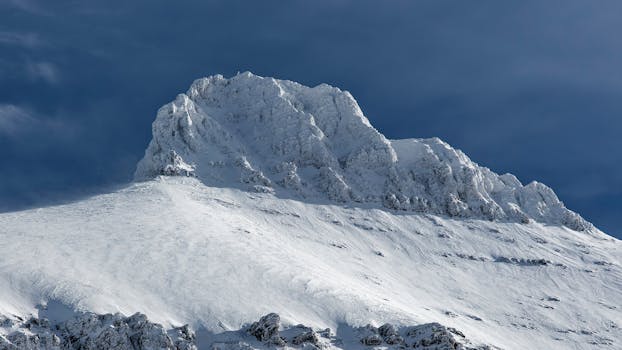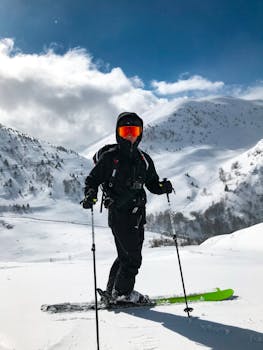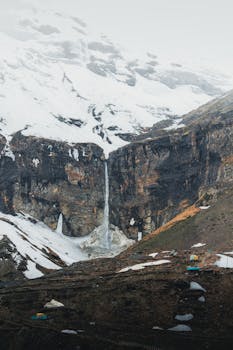Telluride Ski Season: When to Visit & What to Expect (2025)
Everything about Telluride's ski season: opening and closing dates, monthly conditions, crowd patterns, pricing, snow totals, and the best times to visit for powder, value, or avoiding crowds.

Telluride Ski Season: When to Visit & What to Expect (2025)
Telluride Ski Resort typically operates from late November through early April, offering approximately 130 days of skiing across 2,000 acres. However, timing within that window dramatically affects your experience. Snow conditions, crowd levels, pricing, and available terrain vary significantly month to month and even week to week, making your choice of when to visit crucial to your overall experience.
Understanding Telluride’s seasonal patterns helps you choose the optimal time based on your priorities, whether that’s chasing deep powder, finding uncrowded slopes, working within budget constraints, or enjoying family-friendly spring conditions. This complete season guide provides month-by-month breakdowns, insider strategies, and practical advice for planning your perfect Telluride ski vacation.
 Photo by Gilles QUERTIER via Pexels
Photo by Gilles QUERTIER via Pexels
For detailed information about the resort itself, see our Telluride ski resort guide. To understand where to stay during your chosen season, check our best hotels in Telluride for accommodation options across all price ranges.
Note: Prices, dates, and conditions mentioned reflect historical patterns and current season projections. Always verify specific information with official sources at telluride.com before booking your trip, as conditions and schedules change based on snowfall and operational decisions.
2024-2025 Season Key Dates
The 2024-2025 ski season opens on November 27, 2024, the Wednesday before Thanksgiving, and runs through approximately April 6, 2025, offering roughly 130 days of lift-accessed skiing. Opening day typically features limited terrain of 30-40% as the mountain relies on early snowmaking and natural snowfall to build base coverage. Main groomed runs and beginner areas open first, with advanced terrain gradually becoming accessible as snow depth increases.
Full mountain opening usually occurs by mid-December when natural snowfall combines with snowmaking to provide complete coverage across all elevations and aspects. At this point, the resort operates all lifts and opens 100% of named trails, weather and conditions permitting. The exact full-opening date shifts year to year based on early season snow totals—abundant November snow can mean full operations by early December, while dry conditions may delay full access until late December.
 Photo by Melvin Wahlin via Pexels
Photo by Melvin Wahlin via Pexels
Spring closing dates depend entirely on snow year quality and business decisions. Good snow years with deep spring snowpack sometimes extend operations into mid-April, while lean years may close by early April. The resort announces final closing dates in late March once spring conditions become clear. After lifts stop running, backcountry skiing season continues through June for those with proper equipment and avalanche knowledge.
Average Snowfall & Conditions
Telluride averages approximately 131 inches of snowfall annually, translating to about 11 feet of natural accumulation. This relatively modest total by Colorado standards belies the quality of snow that falls here. The resort’s location in the southwest San Juan Mountains produces characteristically dry, light “champagne powder” that skis beautifully even when total accumulation falls below northern resort averages.
Monthly snowfall patterns show November delivering roughly 20 inches as early season storms begin. December averages 45 inches, providing the base depth necessary for full operations. January typically brings 50 inches and represents one of two peak snow months. February maintains strong storm cycles with 45 inches on average. March delivers the season’s highest accumulation at 55 inches as spring storm patterns intensify. April contributes 35 inches, though rising temperatures increasingly produce rain at lower elevations while maintaining snow up high.
These averages mask significant year-to-year variation. Good snow years exceed 350 inches of total accumulation, creating deep powder conditions lasting into late spring. Average years deliver 280-320 inches, providing solid coverage and regular powder resets. Low snow years drop to 220-260 inches, creating thinner coverage, more exposed obstacles, and fewer powder days. The quality of your specific visit depends heavily on current year snowfall patterns rather than long-term averages.
Telluride’s dry snow quality often creates better skiing conditions than wetter climates receiving higher total accumulation. The light, fluffy snow characteristic of this region skis faster, develops less windpack, and maintains better texture across multiple days without fresh snow. This quality advantage matters as much as total snowfall when evaluating conditions.
Month-by-Month Breakdown
November: Pre-Season Skiing
November offers 30-50% terrain open as snowmaking supplements limited natural accumulation. Cold temperatures of 15-35°F allow aggressive snowmaking on main corridors, though variable coverage characterizes the early season experience. Extremely light crowds mean no lift lines and empty groomed runs, while pricing hits season lows with hotels charging $150-250 nightly in most cases.
 Photo by Mikhael Mayim via Pexels
Photo by Mikhael Mayim via Pexels
The limited terrain restricts your options significantly—expect main groomers, beginner areas, and a handful of intermediate runs while advanced terrain remains closed. Rocks and obstacles remain visible in many areas, requiring defensive skiing and careful line selection. Some runs may show bare spots or thin coverage requiring cautious navigation. The cold temperatures can be brutal for less experienced skiers unused to high-altitude winter conditions.
November skiing works best for locals and die-hard enthusiasts who accept limited terrain in exchange for rock-bottom pricing and empty slopes. Destination visitors typically find better value waiting until December when terrain expands and conditions improve. However, Thanksgiving week sometimes delivers surprisingly good conditions if early storms arrive, making it worth monitoring current conditions if you’re considering this period.
December: Building Momentum
Early December (December 1-15) provides 50-70% terrain open with improving snow coverage, very light crowds, and moderate pricing of $200-350 nightly. This two-week window represents one of the season’s best value propositions—sufficient terrain and snow to enjoy quality skiing without the premium pricing or crowds of peak season. Late December (December 16-31) typically reaches 80-100% terrain open if snow cooperates, though Christmas week crowds pack the resort with peak season pricing of $400-1,200 nightly.
The December 10-20 period emerges as the sweet spot for value-conscious skiers. Snowfall has usually built adequate base depth, most terrain has opened, crowds remain minimal outside holiday weeks, and hotel rates stay reasonable. You experience quality early-season skiing without Christmas week’s premium pricing and packed slopes.
Christmas through New Year’s transforms Telluride into a crowded, expensive resort. Hotels require 3-4 night minimums and charge 2-3 times normal rates, sometimes exceeding $1,000 nightly for ski-in/ski-out properties. Restaurant reservations become mandatory, lift lines appear (rare in Telluride otherwise), and the normally mellow town takes on a bustling, crowded atmosphere. If you must visit during holidays, book 6-9 months ahead and prepare for peak pricing across accommodations, dining, and activities.
January: Prime Powder Season
January delivers the season’s best combination of deep snow, light crowds, and reasonable pricing. The resort operates at 100% terrain capacity with excellent coverage across all aspects and elevations. Frequent storms dump fresh snow every 5-7 days in good years, while coldest temperatures of 5-25°F produce the driest, lightest powder of the season. The deep base built through December and early January means most obstacles remain buried, allowing aggressive skiing across the entire mountain.
Early January (January 1-15) sees light to moderate crowds as the post-holiday lull brings emptier slopes and moderate pricing of $250-400 nightly outside MLK weekend. This period represents locals’ favorite time to ski—excellent conditions without crowds or premium rates. Martin Luther King Jr. weekend spikes crowds and pricing briefly, then conditions return to the quiet excellence characterizing mid-January.
The rest of January (January 18-31) maintains exceptional conditions with minimal crowds. Daylight hours remain relatively short with sunset around 5:00 PM, limiting afternoon skiing opportunities. The cold temperatures can be challenging for beginners or those unaccustomed to high-altitude winter weather, with windchill occasionally dropping below zero. However, serious skiers prioritizing powder and uncrowded slopes find January delivers peak Telluride experiences.
 Photo by Visit Almaty via Pexels
Photo by Visit Almaty via Pexels
Booking mid-January provides the sweet spot of deep snow, empty slopes, and moderate pricing. This is when locals ski most frequently, taking advantage of conditions that rival or exceed any other time of season. The cold temperatures and short days represent fair trade-offs for world-class skiing without crowds.
February: Peak Season Excellence
February combines excellent snow conditions, warmer temperatures, and longer days, making it the most popular month for destination skiers. The resort maintains 100% terrain open with consistent storms delivering fresh snow resets every week. Temperatures warming to 10-30°F make skiing more comfortable than January’s bitter cold, while sunset pushing to 5:30 PM extends afternoon skiing time.
Early February (February 1-12) brings moderate crowds and high pricing of $300-500 nightly outside Presidents Day week. Conditions remain excellent with good snow and full terrain access. Presidents Day week (third Monday in February) becomes the busiest non-holiday period of the season with packed slopes, lift lines, and peak pricing approaching Christmas levels. School breaks across multiple states converge during this week, creating the crowded conditions Telluride normally avoids.
Late February (February 19-28) maintains excellent conditions as crowds thin following Presidents Day. Pricing remains elevated but drops from holiday peaks. The warming trend continues with increasingly comfortable temperatures for beginners and families. Snow quality transitions gradually from dry powder toward spring conditions, though most February days still deliver excellent skiing.
For more information on planning your stay during peak season, review our complete accommodation guide for tips on finding availability and best rates.
March: Spring Skiing Transition
March represents the transition from winter to spring skiing conditions. The resort operates 100% terrain through most of March, with upper elevation and north-facing aspects maintaining winter conditions while lower slopes develop characteristic spring corn snow. Temperatures warming to 20-40°F create comfortable skiing weather, though afternoon slush becomes increasingly common as the month progresses.
Early and mid-March (March 1-20) remains busy with overlapping spring breaks from schools across multiple regions. Crowds stay heavy, pricing remains high ($250-500 nightly), and accommodation availability tightens. However, conditions usually remain quite good with regular storms continuing to deliver fresh snow resets. The warmer temperatures make this period ideal for families with young children or beginners still building cold-weather tolerance.
Late March (March 20-31) sees crowds thinning dramatically as most spring breaks conclude. Pricing drops notably as hotels seek to maintain occupancy heading into shoulder season. Conditions become variable with freeze-thaw cycles creating firm morning surfaces that soften into corn snow by afternoon. Strategy becomes important—ski early for firm, fast conditions, then quit by 2-3 PM as slopes turn to mush.
The longer days with sunset around 6:30 PM allow extended skiing sessions and create beautiful afternoon light for photography. The warmer weather enables comfortable deck drinking and outdoor dining without freezing. Afternoon sun creates pleasant environments for families and casual skiers who appreciate less extreme conditions.
April: Late Season Value
April offers limited days before closing (typically April 1-6, 2025) with spring conditions, warm temperatures of 30-50°F, and the season’s lowest pricing of $150-300 nightly. Only dedicated spring skiing enthusiasts or extreme value seekers should plan April trips, as conditions become increasingly variable and many resort facilities begin closing.
The early April days remaining feature corn snow skiing on upper mountain and north-facing slopes, while lower elevations show deteriorating coverage. Morning skiing on firm, frozen surfaces provides decent conditions, but by afternoon everything turns to heavy, wet snow or slush. Limited terrain access becomes normal as thin coverage forces closure of lower elevation runs.
The party atmosphere of end-of-season celebrations creates fun energy among remaining skiers and resort staff. The incredibly cheap rates allow budget-conscious travelers to experience Telluride at a fraction of peak season costs. Sunny, warm days enable t-shirt skiing and deck parties. However, first-time visitors should recognize they’re not experiencing prime Telluride conditions.
For those who enjoy spring skiing and corn snow, April delivers uncrowded slopes, cheap rates, and relaxed atmosphere. Just understand you’re trading prime conditions for value and availability. Advanced skiers sometimes find April offers the best backcountry skiing as the resort closes but high-elevation snowpack remains deep.
Best Times by Priority
For Powder: Mid-January (January 10-25) delivers the coldest temperatures producing driest snow, frequent storm cycles, deep base depth, and light crowds allowing you to track out powder runs at your own pace. Early March (March 1-10) offers a second option with continued storm activity and still-deep snowpack, though warming temperatures slightly compromise snow quality.
For Value: Early December (December 1-20) provides good snow, increasing terrain, minimal crowds, and moderate pricing that represents the season’s best cost-to-quality ratio. Late March (March 20-31) offers a second value window as crowds thin, prices drop, and conditions remain decent for those accepting spring variability. April delivers rock-bottom rates for travelers prioritizing economics over optimal conditions.
For Avoiding Crowds: Mid-January (excluding MLK weekend) stands as the lightest-crowd period with good snow, offering empty slopes and short lift lines during prime conditions. Early December provides a second uncrowded option before holiday crowds arrive. Late March and April feature minimal crowds as the season winds down, though conditions deteriorate progressively.
For Families: Late February (after Presidents Day) balances good snow conditions with warmer temperatures of 15-30°F that keep children comfortable. Early March (first week) continues family-friendly weather with full terrain access and solid snow conditions. Christmas week works if budget allows, offering festive atmosphere and holiday activities, though crowds and pricing are substantial.
For Beginners: Mid-March delivers warm temperatures making learning more comfortable, softer snow cushioning falls, full terrain providing plenty of beginner areas, and longer days reducing pressure to maximize short winter daylight. Late February provides similar benefits with slightly colder temperatures and better snow quality.
Periods to Avoid
Christmas Week (December 23-January 2) combines peak pricing of $500-1,200 nightly for accommodations, heavy crowds creating lift lines unusual in Telluride, fully booked restaurants requiring advance reservations, and 3-4 night minimum stays. You’ll pay three times normal rates for the privilege of skiing crowded slopes. If family schedules force holiday week visits, book 9+ months ahead and prepare for premium pricing across all expenses.
Presidents Day Week ranks as the second-busiest period with high pricing, school break crowds from multiple states, harder restaurant reservations, and slopes feeling uncharacteristically busy for Telluride. Visiting the week before or after provides same conditions and terrain access with dramatically fewer crowds and better rates.
Martin Luther King Jr. Weekend sees brief crowd and pricing spikes despite being a three-day weekend rather than full week. Any other January weekend delivers identical snow conditions, fewer people, and lower rates without the holiday premium.
Snow Report Resources and Tracking
The official Telluride snow report at telluride.com/snow-report updates daily by 6:00 AM Mountain Time with 24-hour snowfall totals, season accumulation, base depths at multiple elevations, and terrain percentage open. This represents the most reliable source for current conditions, though remember the resort measures snow depth at mid-mountain rather than base area, potentially overstating lower mountain conditions.
Third-party services like OnTheSnow.com aggregate multiple data sources providing comparison across resorts. OpenSnow.com ($20 annual subscription) delivers detailed forecasting and analysis with accuracy exceeding free sources. Mountain-Forecast.com provides elevation-specific weather predictions helpful for planning high-altitude backcountry or summit objectives.
Look for 24-hour snowfall exceeding six inches to identify powder days worth adjusting schedules to experience. Base depth above 60 inches indicates good coverage reducing obstacle concerns. Terrain percentage reaching 100% confirms full mountain access. Five to seven-day forecasts help plan optimal visit timing within your available travel window.
Strategic Booking by Season
Peak periods of Christmas, Presidents Day, and February weekends require booking 6-9 months minimum in advance. Expect 2-3 night minimums, prices 2-3 times normal, and limited availability forcing compromises on property preferences. The early booking requirement restricts flexibility but ensures you get accommodations for these highly competitive periods.
Prime season spanning January through February benefits from 3-4 months advance booking, providing reasonable selection while avoiding complete sellouts. Some flexibility remains at this booking window, though premier properties in optimal locations fill earliest.
Shoulder season periods of early December and late March need only 1-2 months advance planning, offering great deals and good availability. Last-minute bookings sometimes work during these periods as hotels offer discounts to fill remaining rooms.
Spring skiing through April enables last-minute bookings within two weeks of arrival, capturing best deals as hotels discount heavily to maintain occupancy as the season winds down. This period offers maximum flexibility for spontaneous trips.
For ski-in/ski-out luxury accommodations during your chosen season, explore places to stay in Telluride to compare current rates and availability.
Final Recommendations
Mid-January (January 10-25) emerges as the overall best time combining excellent snow conditions, minimal crowds, moderate pricing, 100% terrain open, and authentic powder experiences. This window delivers peak Telluride skiing without peak season premiums or crowds. Early December (December 1-20) provides the best value proposition with good snow, increasing terrain, light crowds, and reasonable rates for quality early-season skiing.
Late February (week after Presidents Day) works best for families seeking good conditions, warmer weather, full terrain access, and manageable crowds without holiday chaos. Christmas week, Presidents Day, and MLK weekend represent periods to avoid unless family schedules mandate these times—crowds and prices spike dramatically compared to adjacent weeks offering identical conditions.
Understanding Telluride’s seasonal patterns allows you to choose timing matching your priorities, whether chasing powder in January, seeking value in early December, or enjoying comfortable spring conditions in March. The difference between peak and optimal timing can save thousands of dollars while delivering superior experiences.
 Photo by Nitin Yadav via Pexels
Photo by Nitin Yadav via Pexels
Check current snow forecasts at OpenSnow Telluride for real-time predictions, and explore our complete guide to Telluride activities for planning beyond skiing. The box canyon’s legendary powder and diverse terrain await—choose your timing wisely to maximize your Telluride ski adventure.
Find Your Perfect Place to Stay
Browse our curated selection of ski-in/ski-out lodging, luxury resorts, and budget-friendly options.
Browse Places to StayRelated Articles

15 Best Hotels in Telluride: Top Places to Stay (2025)
The 15 best hotels in Telluride for 2025: luxury ski-in/ski-out properties, boutique downtown hotels, and budget-friendly options. Find your perfect mountain accommodation.

Telluride Ski Resort: Complete Guide (2025)
Everything you need to know about Telluride Ski Resort: terrain breakdown, lift system, best runs, ticket prices, expert tips, and how it compares to other Colorado resorts.

Things to Do in Telluride: Ultimate Activity Guide (2025)
Complete guide to activities in Telluride: skiing, hiking, mountain biking, festivals, hot springs, dining, gondola rides, and 50+ ways to experience this mountain paradise year-round.
